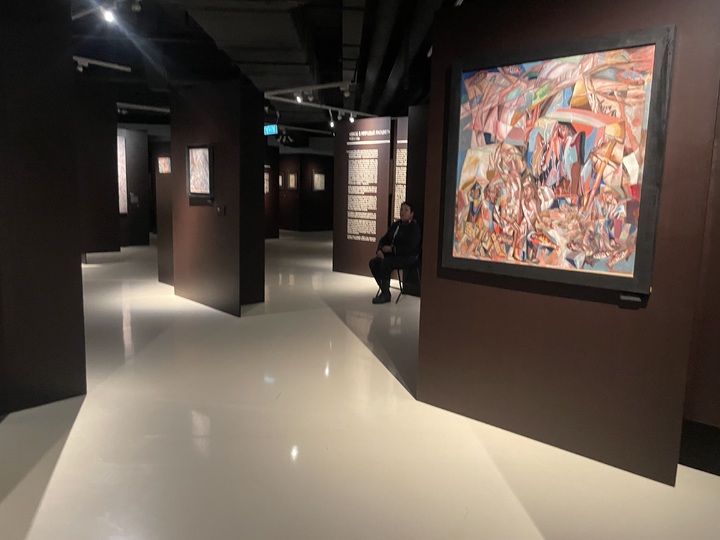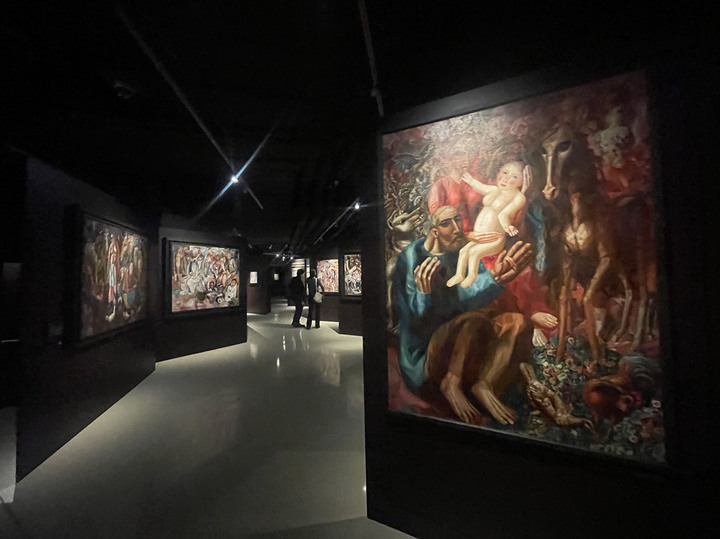An exhibition dedicated to the 140th anniversary of the most mysterious artist of the 20th century has opened in Moscow.
[ad_1]
In the basement of the Kremlin, the world was broken down into atoms
An exhibition of Pavel Filonov dedicated to the 140th anniversary of the master has opened in Zaryadye. The exhibition includes more than 60 works: the last time they could be seen in this volume was 20 years ago at the Russian Museum. It is symbolic that the works of one of the leaders of the avant-garde, who at the end of the 1920s became persona non grata for the authorities, lost all means of subsistence, was forced to work as a table worker and eventually died of hunger during the siege of Leningrad, are shown in the basement hall in two steps from the Kremlin. What the founder of the school of analytical art was like was seen by the MK art observer.
People were allowed into the opening of the exhibition, prepared by ROSIZO together with the Russian Museum, in small groups wearing multi-colored bracelets, so as not to create a crowd at the exhibition and to give the public the opportunity to see the paintings and not other people’s backs. Therefore, many waited for their turn for hours. Interest in the work of Pavel Filonov, who occupies a special place among his avant-garde contemporaries, is enormous today. At one time he was one of the most banned artists and to this day remains one of the most mysterious figures on the art scene of the twentieth century.
The viewer in the darkness of the basement hall is instantly captivated by the movement in Filonov’s paintings: the accent lighting of the canvases highlights the kineticism and logic of painting. The architecture of the exhibition allows for pauses at each work: it resembles a river with a broken, zigzag bed, which beats first against the left and sometimes against the right “bank”, and then rests against a rock and makes a sharp turn. The logic of immersion in Filonov’s work reflects his concept, where the movement from the particular to the general is important and where the picture develops from a point, like a sprouting grain. Thus, Filonov’s idea of “world flourishing” (with emphasis on the second syllable) is revealed gradually – from a small pencil portrait (represented by a copy in a lightbox) to large canvases with many details, where the plot is decomposed into atoms and molecules. In this way, the artist shows not only the visible world, but goes beyond it, trying to comprehend the invisible processes of the world order.
Filonov was not just keenly interested in the scientific works of his time, be it Charles Darwin’s theory of evolution or Einstein’s theory of relativity, but dissected them through pictorial means. At the Institute of Artistic Culture, where he was a professor and taught his course, a separate school developed around the artist. Its ideas were visualized on Filonov’s canvases and set out in writing in the “Declaration of World Prosperity,” which began to take shape on the eve of the First World War, and was finally formed by 1923. “In any object there are not two predicates, shape and color, but a whole world of visible and invisible phenomena,” he writes in his declaration, denying all “beliefs in painting, from the extreme right to Suprematism and constructivism” and putting forward his own principle – “biologically the picture made.” For the artist, the world is the Universe, where every atom is interconnected with the infinity of the Universe; on his canvases he tries to capture the incessant movement of all things. Moreover, the concept of time is relative for him. Therefore, iconographic images appear in his works every now and then, as in the work “The Holy Family” or “The Virgin and Child.”

Filonov’s ideas were presented quite voluminously by the curator of the exhibition from the Russian Museum, Evgenia Petrova, who 20 years ago did a project for his 120th anniversary in the Benois Wing. And yet there are gaps in the “moving” exhibition. Here is a text about the artist, and next to it there are several empty niches where some kind of work begs to be filled, but there are none. This is unlikely to be due to the fact that only in the last few decades the artist began to be rediscovered – to this day his philosophy is not fully understood. But even in these gaps there is something symbolic.
Once upon a time, the Russian Museum put an end to Pavel Filonov, but now he is rediscovering it. So, at the end of 1929, an exhibition of Filonov opened at the State Russian Museum – and immediately closed, and even at the stage of preparation of the project, problems arose: a catalog article about Filonov, written by Nikolai Punin’s assistant Vera Anikieva, was replaced with a text by art critic Sergei Isakov, who questioned the value of the artist’s work. At the opening, the same Isakov made a speech condemning the master, but the workers, having listened to it, began to look at the works and did not agree with the art critic. Eyewitnesses recorded some comments: “Whoever was in the German War will understand Filonov’s picture “German War”; “As a new quest, the exhibition should be welcomed. There is no need to be embarrassed by what is incomprehensible.” And yet Isakov stood his ground – the exhibition was closed. The artist had to carry the paintings on his own shoulders from the museum. Since then it has not been exhibited again. Finding himself deprived of his livelihood and the opportunity to earn money, he did not sell his paintings and taught for free. Miraculously, his sister saved the archive and paintings.

The mentioned “German War” is also in this exhibition. There is frantic movement in it, a heavy feeling of violence and rage, decomposed into atoms. The painting’s power is comparable to Picasso’s Guernica, although it is smaller in size. Just after this, there is a turn in the movement along the “channel” of the exhibition, and then – the works that were written on the table. In the first part, along with the revolutionary nature of Filonov’s method, a deep connection with history and icon painting is felt. Moreover, the figures have double and triple fingers and toes, as if the artist caught their movement, although the modern viewer cannot help but notice the connection with the paintings that are simulated by artificial intelligence. According to Filonov, the world falls apart into its components and comes back together again. It’s strange that in the early works there is more darkness and heaviness, but in the latter, on the contrary, they seem to be scorched by light. Numerous images, lines, details seem to be erased, leaving behind a mirage of movement.
[ad_2]
Source link






